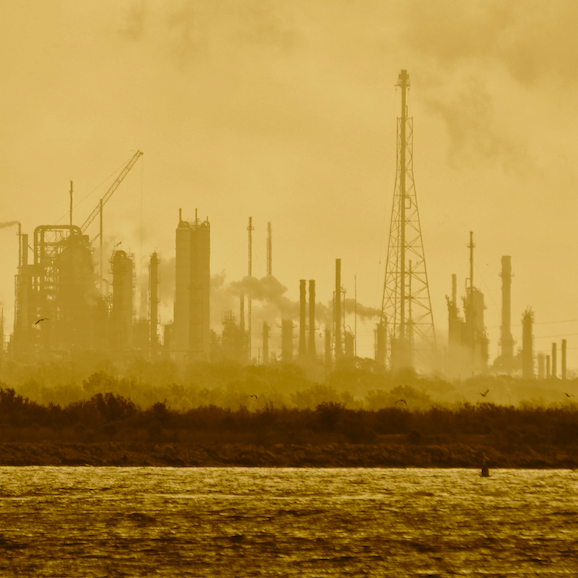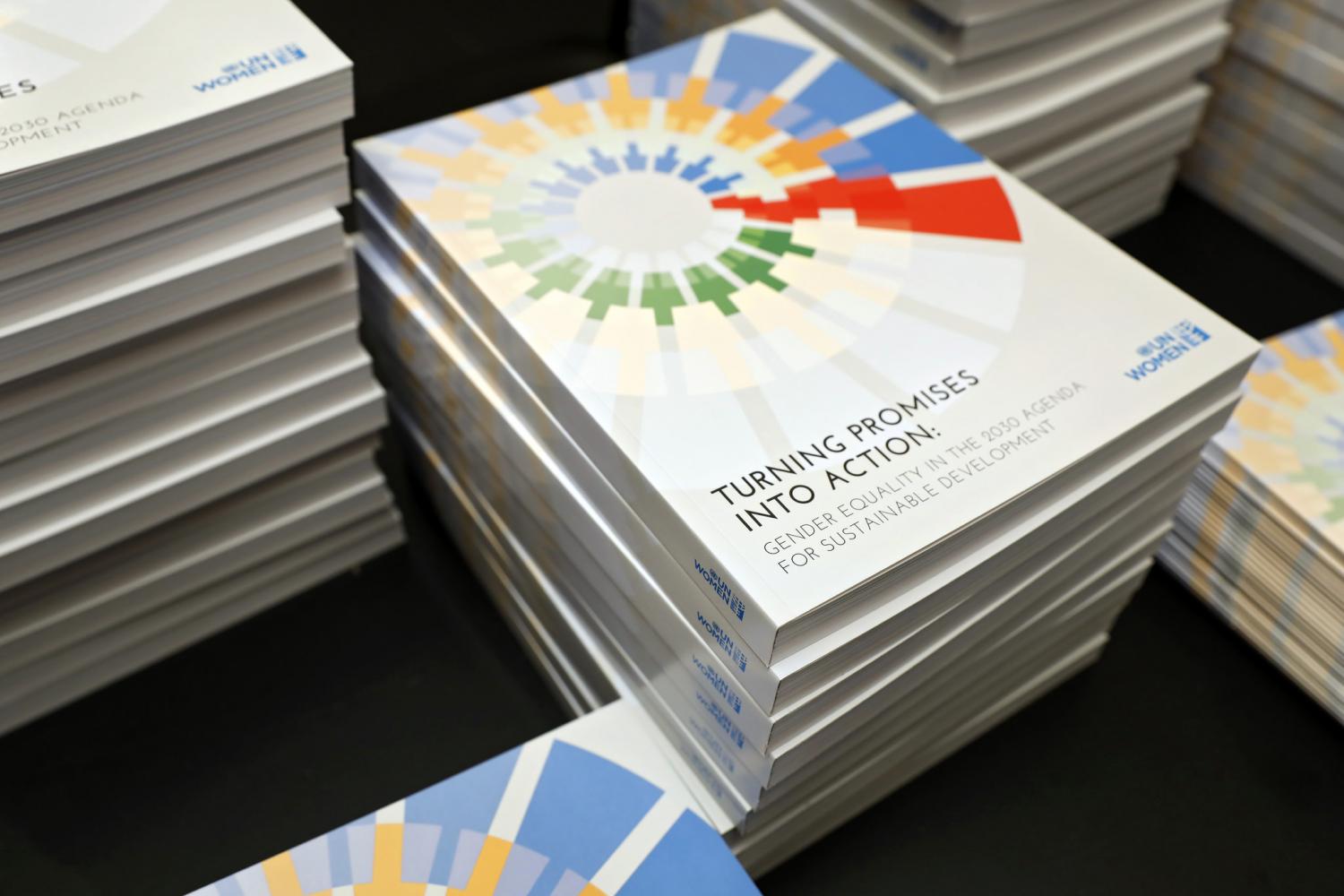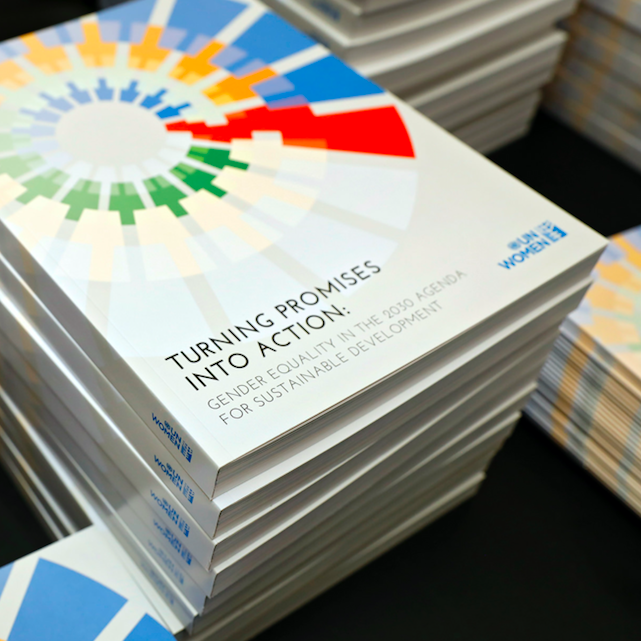Brands Are ‘In a Race’ To Keep Up with Conscious Consumers, Says CDP


Some of the world’s most recognizable brands are “in a race” to keep up with rapidly shifting consumer preferences, according to a new report from CDP.
Some of the world’s most recognizable brands are “in a race” to keep up with rapidly shifting consumer preferences, according to a new report from CDP.
The United Kingdom-based organization analyzed 16 of the largest publicly-listed food, beverage, household and personal care companies—and its report, released on Monday, paints a picture of industries in flux. As investors demand more information about top companies’ exposure to climate change, shifting consumer attitudes around what to buy—and who to buy from—are leaving companies in catch-up mode.
The votes are in: consumers want healthier, more sustainable products
In the food sector, more than 60 percent of Americans cite healthfulness as a primary driver of their purchases, surpassing even convenience, according to a 2018 survey conducted by the International Food Information Council Foundation. Another 59 percent said they feel it’s important for the food they buy to be produced sustainably, and over a third are eating more plant-based foods. In response, five of the seven food and beverage companies that CDP analyzed—including Danone and Nestlé—are developing vegan, plant-based alternatives to dairy and meat products.
Health-focused and sustainable personal care products are seeing a similar rise in popularity, with nearly 70 percent of global consumers having purchased natural or organic toiletry products in the past year. Likewise, in this category, six of the seven firms CDP analyzed—including L’Oréal—are introducing biodegradable ingredients and actively looking to phase out petrochemicals. Unilever is among four leading personal care companies to have developed vegan personal care product ranges.
Can M&A win the day?
Along with creating new products, many companies are looking to quench consumers’ shifting tastes by acquiring smaller, sustainable and health-focused brands. Of the companies CDP analyzed, 75 percent have acquired a niche, environmental brand over the past five years, and this type of activity has more than quadrupled over that time. Some recent examples include Nestlé’s acquisition of Sweet Earth and PepsiCo’s purchase of Bare Foods.
Still, some companies have faltered in their attempts to expand into emerging categories. Last year, Campbell Soup Company laid out plans to sell off its international and fresh food businesses—including newly-acquired, health-focused brands like Bolthouse Farms and Garden Fresh Gourmet. The surprise move came after years of building its portfolio through mergers and acquisitions, in response to what former CEO Denise Morrison called a “seismic shift” in eating habits. But company leadership said the legacy food giant was ill prepared to enter the growing fresh foods segment.
“We aggressively pursued the important consumer mega trend of health and well-being without having clarity on our source of uniqueness or whether we brought a competitive advantage to the space,” interim President and CEO Keith McLoughlin told Philadelphia Magazine.
Scrutiny around packaging indicates broader rise in consumer activism
Even as companies struggle to keep up with rising demand for healthy, sustainable products, they must also contend with rising scrutiny around their reliance on single-use packaging, CDP warned. A third of U.S. consumers and over half of those in the U.K. support a tax on all plastic food packaging, according to a recent survey. Additionally, in 2018, a group of 25 institutional investors with a combined $1 trillion in assets called plastic pollution a “clear corporate brand risk,” and several governments—including the European Union—are considering more robust rules on packaging and waste.
In response, around 60 percent of the companies CDP analyzed are investing in biodegradable plastic and recycling infrastructure. But pushback against plastic is likely only the start of what’s to come with respect to consumer activism, said Carole Ferguson, head of investor research for CDP. “Ongoing activism around plastics and packaging is just the tip of the iceberg,” she predicted in a statement. “We expect to see more environmental issues come to the fore as consumers start to question what goes into the products they buy, use and dispose of.”
The bottom line
Some companies stand out in navigating these rapidly shifting waters. Danone, with its pledge to achieve completely circular packaging by 2025, leads the food and beverage sub-sector, along with Nestlé, according to CDP’s report. Unilever and L’Oréal—both previously recognized by CDP for their efforts to cut carbon emissions—lead household and personal care.
Still, almost 60 percent of the top 10 revenue-generating brands for each company CDP analyzed have failed to deliver low-carbon innovations in the last 10 years. Given that most companies generate over half their revenues from these key brands, “they must up their game or risk falling foul of changing consumer demands,” CDP concluded.
“As consumer-facing brands, at risk not just from climate change but water scarcity and deforestation too, these companies have a unique role to play in driving forward the sustainable economic transition,” said Ferguson of CDP. “Leading companies are taking action across their entire value chain and redefining the role of business in society … these efforts need to be replicated by others in the sector, if they are to justify their role in a society that can no longer be based on fast-paced, rising consumption and linear business models.”
Image credit: Artem Bali/Pexels
Human-Centric Technology Key to Palm Oil's Image Transformation


In the palm oil industry, technology can help us look for evidence of deforestation, but it won't tell you why it is happening and it generally won't help you identify who is responsible.
Recent articles have asked whether “big brother” technology can clean up palm oil's image. As we edge ever closer to the "no deforestation" targets of 2020 set by major consumer goods (CPG) companies, these same companies are increasingly turning to satellite monitoring technologies as a means to prove that their own supply chains are deforestation-free.
Palm oil, in particular, has been identified as a sector needing an "eye in the sky" approach given its past track record in contributing to global forest loss.
Technology is not a panacea
So is technology the answer we've all been looking for? The short answer is no. Technology can tell you where to look in terms of deforestation happening, but it won't tell you why it is happening and, usually, it won't help you identify who is responsible.
Which is not to dismiss technology's important role in helping us to manage landscapes. As Mark Tercek recently wrote, implementing massive deforestation commitments requires sophisticated tracking and monitoring technology, much of which did not exist, or was not as accessible, prior to the establishment of the 2020 NDPE (No Deforestation, No Peat, No Exploitation) commitments.
Indeed, GAR was among the first palm oil companies to adopt technology not only in the day-to-day monitoring of the performance of our own plantation estates but also in assessing which forests we should set aside for conservation as we piloted the High Carbon Stock Approach. Satellite monitoring and other technologies also play an essential part in our fire prevention strategy, allowing us to quickly identify and then assess hotspots and act to prevent a repeat of 2015's horrific fire season.
Greater affordability and availability have allowed technology like the use of drones to become more commonplace. The labor and time-saving nature of these devices is a key contributor to their uptake. Why not use a drone to conduct boundary monitoring of a conservation zone, when it can do in hours what would have taken significantly more time if people were deployed to walk such boundaries? Having identified and set aside 72,000ha of forest for conservation in line with GAR's Social and Environmental Policy (GSEP), we now use drones to help us ensure those forests are not lost to encroachment or fire.
All of us in the industry need to be more proactive
If technology can help us spot land use change and react more quickly, why isn't it the answer we've all been looking for? Because it is not a tool of prevention. Yes, being able to react more quickly, preventing more harm that may have otherwise been possible without the Big Brother approach, is an important step forward, but you are still reacting to a change in the landscape. For prevention, you need people.
A human-centric approach to the use of technology in agriculture remains necessary if we are to understand the motivations behind deforestation, and even to determine whether something that looks like deforestation on a satellite image is deforestation. Investment in on-the-ground teams who can engage locally to determine what lies behind the land use change is essential to determine whether that "deforestation" is actually the replanting of an existing plantation or farm, or a community garden as opposed to primary forest.
Technology cannot teach farmers new farming practice, nor can it engage a corporate landowner to persuade them to stop the bulldozers and adopt a different approach. Human beings must still play a role in the transformation of the palm oil sector.
That is why GAR invests not only in technology but in prevention and education efforts. Our supply chain transformation team utilizes technology along with human capacity building and engagement to help transform the sector.
Take for example our commitment to supply chain traceability. Technology plays a vital role in this. Using smartphones and handheld GPS devices linking to an online platform, GAR has achieved 100 percent traceability to plantation (TTP) for its own mills and is now working with its third-party supply chain to achieve the same target by 2020. At the time of writing, we have achieved 62 percent TTP for GAR's supply chain. Solution providers like Geotraceability, Bluenumber, and Koltiva play a pivotal role in helping achieve this target.
Technology cannot replace human relationships
To secure the buy-in of suppliers to use these systems, we first have to invest in relationship and capacity building exercises. It is an investment in trust building. Suppliers want to know that the information they share won't be used to penalize them or to bypass them altogether and go directly to their suppliers. GAR invests in a supplier transformation program that offers those reassurances.
For example, GAR's SMART SEED event brings together more than 100 suppliers annually to discuss issues that, through our risk assessment and traceability engagement, we have identified as common to the sector. For example, human rights and labor regulations in the sector, or how to become certified to national and international standards such as ISPO and RSPO.
Alongside one-to-many education and training events like SMART SEED, GAR teams have conducted more than 90 supplier site visits, where action plans are supported and intensive training and capacity building provided to help suppliers understand and meet the expectations of the global palm oil marketplace. Direct engagement like this has helped us reach agreements that have seen almost 68,000 hectares of forests conserved by our suppliers.
The technology that we are experimenting with to achieve traceability to plantation will also be useful in enabling access to markets and to financing for individual smallholders. Not only can it provide the assurances sought by consumers in developed markets, but it can also play a role in connecting oil palm farmers with organizations that can help them farm better, increasing their production, and to become better business owners, developing other economic opportunities.
As the world, even rural Indonesia, becomes more connected, there are many other productivity increased possibilities that the Internet of Things (IoT) may deliver to farmers and companies alike. Examples include finding alternative transportation means, sources of fertilizer and other agri-inputs and financing schemes for small and medium enterprises.
Technology is not only about circulating satellites high in the skies. It is also the appropriate technology that E.F. Schumacher once described in Small is Beautiful, where losses can be reduced by modifying buckets, where fertilizers can be trickled through pipes, where drones can help the harvesters on old trees and where the human assets on the ground deliver creativity and ingenuity to solve problems.
If the 'Big Brother' technology to which major consumer goods companies are now turning is used only for the purposes of cutting growers from supply chains, then we are not affecting change in the industry. GAR has a responsibility as a leading player in the Indonesian palm sector to help other growers - especially smallholders - improve yields, meet market expectations and avoid deforestation.
A human-centric approach to technology use is helping us to do just that. Companies sourcing palm oil need to be investing in both solutions - the technological as well as the human capacity building - if we are to see the kind of transformation of the sector, GAR and other industry leaders have been working towards for the past five years.
Image credit: GAR
Can Purpose-Driven Business Fix Broken Capitalism?


The most common question in the Brands Taking Stands era is “What’s next?” We're reaching answers through a process of so-called “creative destruction.” And, proposals once dismissed as “radical” are attracting more support.
Is the daily disorder in our society beginning to feel historical? There is a growing sense that our governing institutions and practices are out of control and beyond our control, and that events are re-shaping life as we know it. Are we at one of those momentous “hinge” moments in history, when the known world dissolves but it’s not yet clear what is to come next?
In recent times, 1968 was such a transformative year, one which set the course for the next 50 years in culture, politics, and economics. It was a year with a raging war in Vietnam, the assassinations of Dr. Martin Luther King and Robert Kennedy, protests and demonstrations for and against a menu of causes, and an economy that was beginning to wobble into unprecedented deficits and growing inflation under the heavy costs of war and ambitious social programs. It culminated in the election of a president who was later forced to resign to avoid impeachment.
1968 also included the rise of Black Power and the beginnings of the feminist movement, the creation of multiple counter cultures, a back-to-the-land movement, the growth of rock music into a powerful force, and a youth-oriented entertainment industry. The consequences of these responses to social and political crises are still being played out today by this generation’s huge cohort of Baby Boomers (some 75 million strong).
1968 set social, political, and economic patterns for 50 years
Entire books have been written about 1968, variously referred to as “the year that rocked the world,” “the year that changed the world,” and “the year that shaped a generation.”
The parallels with current events in the social, political, and economic spheres are spookily obvious. As Mark Twain said, “history may not repeat itself, but it sure does rhyme.” 1968 was a year that separated the past from the future, sometimes violently, as new solutions to old problems became the default mode of action. For business, the consequences have been—and continue to be—immense.
2018: a year of “creative destruction”
Today, it seems that the fundamental economic model rooted in those revolutionary times is being called into question as never before. Whatever its virtues, business practices and strategies dating back 50 years are clearly inadequate to the demands of the day. Brands are now taking unprecedented stands on key social and political issues, and companies are integrating purpose into their missions and strategies.
The most common question in this era is “What’s next?” Answers are increasingly being formulated through a process of so-called “creative destruction.” Proposals once thought “radical” are attracting significant support. New networks and associations have formed, new ways of doing business are being put into practice, and most importantly, new ideas about a much more expansive view of business are spreading: “Green New Deals,” for example.
When the CEO of the world’s largest investment fund, Larry Fink of BlackRock, calls for companies to have a “social purpose,” you can bet that a paradigm shift is in the making. “Profits are in no way inconsistent with purpose–in fact, profits and purpose are inextricably linked,” says Fink. Financial Times, the voice of the global financial establishment, is chiming in, asking, “Should business put purpose before profit?” And for an affirmative answer, it quotes Oxford’s Colin Mayer who defines corporate purpose as “producing profitable solutions to problems of people and planet.” And Bloomberg News has joined the chorus with an idea-rich position article, “Seven Fixes for American Capitalism: Ideas from the Right, the Left, and Across the Atlantic" to mend what’s broken in our economy. Clearly, a new economic agenda is in the offing.
Business is stepping up to shape the change we need
Business is not waiting for this momentous change to take effect, but is hard at work shaping the change that is needed for future viability.
One substantial forecast comes from CECP: The CEO Force for Good, an organization that “empowers corporations to be a force for good in society.” In a statement titled “How Purpose and Culture are Driving Sustainable, Long-term Growth and Profitability,” CECP CEO Daryl Brewster poses the fundamental issue: “It’s clear that effective companies cannot ignore social needs in pursuit of profit, but how do businesses navigate what’s coming and what role do they play in solving social challenges?”
The answers are outlined in its report, "Measuring the Value of Corporate Philanthropy: Social Impact, Business Benefits, and Investor Return." The details are set up in three buckets, “identifying three vital audiences that companies must engage to measure and communicate business’ social impact: 1) investors, 2) internal, and 3) significant stakeholders.”
CEO leadership is key: “CECP guidance is rooted in issue areas that were identified through investor feedback and a suite of research that provides specific guidance to companies to structure an effective long-term plan, building towards consolidation and comparability. Through these long-term plan presentations, leading CEOs are setting examples for their peer firms to follow.” The focus is on “effective long-term plans that address key issues of long-term value creation, such as overall corporate purpose, strategy, human capital, and corporate governance.”
There’s much more to digest in this ambitious but clear-headed position paper—read the details here.
The good news is that thoughtful people are laying out insightful plans to turn progressive ideas into practical action.
Previously posted on the weekly Brands Taking Stands newsletter. Be sure to subscribe!
Image credit: Fibonacci Blue/Flickr
If Rivian Becomes the Tesla of Pickup Trucks, then Adios to ICE Engines


Tesla has long dominated the electric vehicles conversation, but that’s about to change with the emergence of Rivian and its all-electric pickup trucks.
Tesla usually dominates the conversation whenever the topic turns to electric vehicles, but that’s about to change. Last year Rivian, a startup also based in the U.S., introduced its first electric vehicle (EV) pickup truck and an SUV model, too. The company has already attracted a new round of $700 million in funding from a group of investors spearheaded by Amazon.
Hold on to your hats! After years of slow growth in the EV sector, Amazon’s move demonstrates how quickly the automotive marketplace could pivot to zero emission mobility — with or without support from federal policy makers.
The Rivian EV pickup truck: yes, a pickup, without the emissions
The new $700 million electric vehicle investment is especially significant because Rivian is going toe-to-toe with Tesla to capture the luxury branding market for electric vehicles, and it is stepping into a sector that Tesla has yet to develop.
The idea of pickups as a luxury brand may seem counterintuitive, but high end pickup trucks similar to a past Cadillac’s Escalade SUV-style pickup have already piqued more consumers’ interest.
In addition, many auto makers have already gained traction with consumers by loading pickup cabins with comfortable amenities.
With that head start, Rivian concentrates on identifying its brand with top level performance, through a singular focus on EV technology from top to bottom. The company describes a “clean sheet” approach that fosters “adventurers at the core of every design and engineering decision.”
Rivian is also laser-focused on comparing its R1T pickup with the best that internal combustion engines have to offer in terms of performance. Here’s an example from the company’s website:
“The Rivian electric drive delivers remarkable power and torque through four independent motors — with 200 horsepower available at each wheel. This precise torque control enables active torque vectoring and maximized performance in every situation, from high-speed cornering to low-speed rock crawling — rain or shine.”
In addition, the company declares an impressive battery range of more than 400 miles for its EV pickup truck.
Ruh-roh Tesla, here comes Amazon
Speaking of head starts, Tesla is miles ahead in the publicity department, but the new Amazon-led investment could go a long way toward making this race an even match.
For one thing, Tesla has yet to introduce a pickup model. That provides Rivian with an opportunity to stake out a unique identity for itself — an opportunity it has seized, by emphasizing the pickup as an outdoorsy and off-road experience. That’s in contrast with Tesla’s image, which focuses on sleek urban mobility.
Rivian founder and CEO RJ Scaringe also emphasizes the power of aligning the company with Amazon’s technology platform, as he explained in a press statement:
“. . .Beyond simply eliminating compromises that exist around performance, capability and efficiency, we are working to drive innovation across the entire customer experience. . .”
On Amazon’s part, the company may anticipate that a fleet of owner-drive pickup trucks would expand its delivery capacity and provide for more leverage when negotiating with conventional delivery partners like UPS.
GM spots an opportunity
With the $700 million in hand, Rivian has now attracted investments worth $1.15 billion.
General Motors is reportedly in talks with Rivian. If that relationship moves forward, it could evolve into a collaborative partnership, possibly focusing around self-driving technology.
GM envisions rapid consumer adoption of self-driving technology and Rivian is also highly vested in self-driving EV mobility.
Amazon and the gig economy
One note of caution applies to the potential for Amazon to grow its delivery network with owner-driven vehicles through the Rivian investment.
The rise of the gig economy is one factor in the stagnation of worker wages over the past generation. The new Amazon venture could exacerbate the trend by pushing the ride-hailing model into the delivery sector.
On the other hand, Amazon has been getting its social responsibility house in order. The company has made notable progress in supply chain areas including packaging and renewable energy.
Amazon’s reputation on employee relations is more mixed. The company’s recent statements on human rights pave the way for a more balanced approach, but there is still a long way to go.
The concern would be that Amazon’s shortcomings in the area of worker treatment could ripple into Rivian’s manufacturing operations.
In terms of brand reputation that’s no small concern, considering that Rivian has set up operations in a 2.6 million square foot manufacturing plant located in Norman, Illinois. The Rivian operation will take over a space vacated by Mitsubishi just three years ago.
In terms of employee relations, Rivian would do well to learn from Tesla’s experience. While Tesla garners rave reviews for its EV technology, the company has long been dogged by various media stories on anti-union practices and other worker complaints at its California manufacturing facility.
Image credit: Rivian/Facebook
Walmart Sparks a Multi-Stakeholder Effort to Fight Hunger in the U.S.


This article series is sponsored by Walmart and produced by the TriplePundit editorial team.
There is strength in numbers, especially for a cause as important as fighting hunger among the more than 40 million Americans who are food insecure. That’s why Walmart has rallied its customers, suppliers, and 1.5 million associates at almost 5,000 U.S. stores to join in a campaign to fight hunger and spark change.
Launched in 2014, the “Fight Hunger. Spark Change.” campaign helps support Feeding America—the nation’s largest domestic hunger-relief organization—and its network of 200 local member food banks. The campaign raised $23 million in 2018, enough to help Feeding America secure a record 230 million meals for food-insecure households.
A cause that unites everyone
The success of the campaign is highly dependent on Walmart associates’ and customers’ dedication to addressing hunger, Megan Crozier, senior vice president of food merchandise at Walmart, told TriplePundit. “This is a cause that unites everyone: our associates, customers, suppliers and partners. Food insecurity in America could be affecting your neighbor or even a family member. We wanted to bring attention to this issue with this campaign.”
People are always surprised when they read the statistics on hunger in the U.S. “This is an easy rally cry for anyone once they find out the extent of the problem, how it exists in every community and in every neighborhood in America,” Crozier said.
Walmart gets the word out about the campaign in multiple ways—mobilizing customers and associates to raise awareness around hunger and food insecurity. Signs, promotions and other in-store features inform customers about the campaign. Donations can be made at the register at point of sale. “Register contributions are a huge source of donations,” Crozier explained. “Customers are really engaged around our hunger relief efforts when they shop our stores.”
Partnering for change
Suppliers and partners also play a huge part in this multi-stakeholder endeavor to battle food insecurity, Crozier added. “We have suppliers excited to participate in the campaign,” she said. “Their business focus is on food, so naturally they want to get involved; it is a great story to be told, a smart business decision as well as the right thing to do.”
In April 2018, Walmart collaborated with Nextdoor, a private social media network active in 170,000 neighborhoods nationwide, and Neighbor’s Table, which builds and delivers handcrafted tables, to hold a series of events across the U.S. focused on bringing diverse groups together to discuss the nation’s hunger crisis and how communities might best address it.
Working with Feeding America and Nextdoor, Walmart invited community leaders, city officials, local chefs, local food banks, journalists and area neighbors to come together around handcrafted tables made by Neighbor’s Table. The table remained as a gift in each community, so neighbors could continue to discuss how to best combat hunger locally. Following the gatherings, community members were invited to learn more about ways they could help their local food bank.
The idea was that many problems can be solved just by having a conversation, especially when it involves sharing a meal around the table. “The best ideas come from our associates, customers and suppliers,” Crozier said. “We are excited to see what they come up with during this year’s campaign to further the fight against hunger.”
Image courtesy of Walmart
ExxonMobil’s Climate Change Pivot Speaks Volumes about Shareholder Activism


Pension funds and other big-dollar investors have long been challenging fossil fuel companies on climate change. ExxonMobil has been able to fight back against such shareholder resolutions, but cracks in the energy giant's armor are finally beginning to show.
Pension funds and other big-dollar investors have long been challenging fossil fuel companies on climate change. In response, some have stepped up their efforts to cut greenhouse gas emissions. ExxonMobil is one of the holdouts, but cracks in its armor are finally beginning to show.
Reuters recently reported that the company has written a letter to the U.S. Securities and Exchange Commission (SEC), asking the agency to block shareholders from voting on a proposal that would force the company to set greenhouse gas targets.
Climate change: money talks
The SEC request is significant to the degree that it reflects ExxonMobil’s concern over losing control of the climate change narrative.
For many years, ExxonMobil was a powerful force on the public debate about climate change, here in the U.S. and to some extent abroad.
Even as overwhelming scientific consensus pointed to the connection between climate change and human-caused greenhouse gas emissions related to fossil fuels, ExxonMobil garnered considerable notoriety for funding “think thanks” and other lobbying efforts aimed at side-tracking the issue and diffusing concern.
In recent years, however, the facade has begun to crumble. Climate change is a matter of now, not when, and certainly not if.
As more risks and effects pile up, the debate over climate change has shifted. The earlier focus was on environmental protection. Now the concerns include financial risk. This current focus provides shareholders with a firm bottom line platform to advocate for change.
Shareholders revolt over climate change
ExxonMobil is facing legal action over climate change on a number of different fronts, including the potential for charges of racketeering.
The letter in question is a response to a new threat, a first-of-its-kind shareholder resolution filed last December by a group of institutional investors.
The group is spearheaded by New York State Comptroller Thomas P. DiNapoli on behalf of New York State’s pension fund.
The resolution asks ExxonMobil to disclose short-, medium- and long-term greenhouse gas targets that are consistent with the Paris Agreement, beginning next year.
In addition to New York State, other institutional supporters of note are CalPERS, HSBC Global Asset Management, Presbyterian Church USA, SHARE on behalf of Fonds de Solidarité des Travailleurs du Québec, and the Church Commissioners on behalf of the Church of England.
All together, these groups have an estimated $1.9 trillion in under management, as estimated in the sustainable investing group Ceres.
ExxonMobil pushes back
According to the Reuters report, the investor group believes that ExxonMobil’s argument against the shareholder resolution rests on the idea that it is an attempt to “micromanage the company.”
The micromanagement argument does hold some sway at SEC. Last year, for example, the Los Angeles Times noted that SEC blocked a shareholder proposal that would have required Dunkin’ Donuts to disclose the environmental impact of its K-Cup Pods packaging.
SEC justified its action on the basis of proportionality, explaining that the K-Cup resolution would impact only a small fraction of the company’s business.
In that light, ExxonMobil’s “micromanagement” argument is fairly weak. The shareholder resolution in question would impact every aspect of the company’s core business, not a mere fraction of it.
The micromanagement argument also loses weight considering that other oil and gas companies have already begun to disclose their greenhouse gas emissions, set targets, and even incentivize executives to cut emissions in response to shareholder concerns.
In addition, other legacy oil and gas companies, most notably Shell, Statoil and BP, are racing far ahead of ExxonMobil to diversify their holdings into renewable energy and electric vehicles.
On the other hand, last year ExxonMobil successfully appealed to the SEC over the “Low Carbon Business Model” resolution proposed by the socially responsible investor organization As You Sow and Arjuna Capital.
One word: plastics
In 2017, Carbon Tracker surveyed 69 of the world’s largest publicly traded oil and gas companies. It found that ExxonMobil was far and away leading the group in exposure to risks from unneeded future projects.
One problem for ExxonMobil is that a main focus of its growth plan involves stepping up its natural gas holdings.
Here in the U.S., the company has played a major role in driving coal out of the power generation sector.
However, evidence is mounting that greenhouse gas emissions from natural gas operations are neutralizing the benefits of burning less coal.
More to the point, renewable energy is already beginning to beat both natural gas and coal in the U.S. power generation market when it comes to efficiency and competitiveness.
A growing movement to transition buildings in the U.S. away from natural gas will also cut into that market.
ExxonMobil and other fossil stakeholders have been ramping up their petrochemical operations, anticipating a rapid pace of growth in the demand for plastic products in Asia and other emerging economies.
However, a countermovement to reduce plastic dependency is also rapidly growing. In addition to grassroots activism, major companies like AB InBev and Kao are taking action to reduce plastic in their supply chain.
One way or another, ExxonMobil and its shareholders face a day of reckoning.
Meanwhile, if the SEC allows the new shareholder resolution to move forward, a vote on the proposal is expected in May.
Image credit: Roy Luck/Flickr
Ford Approaching Electric Scooters with Care


Ford’s “last mile” strategy pivots on attracting a new generation of mobility consumers by building on its long-trusted brand reputation.
When Ford acquired the electric scooter company Spin last year, it looked like a pretty smart move. After all, the urban landscape is rapidly pivoting to embrace more two-wheeled, zero emission forms of transportation.
On the other hand, the urban electric scooter movement has hit some major speed bumps in terms of public image. A large part of the problem is that users of app-based, dockless rental systems tend to drop off their scooters willy-nilly. They block sidewalks, clutter the streetscape, and create a costly enforcement headache for local officials. Pedestrian safety and liability are other big issues. As a result, more cities and college campuses are beginning to clamp down on the app-based electric scooter business.
So, how does Ford expect to dive into this market without damaging its public image? At its core, Ford’s strategy pivots on attracting a new generation of mobility consumers by expanding its brand reputation for trust.
Brand reputation and electric scooters, Lesson One
The brand reputation issue has been simmering for a while. It came into sharp focus earlier this month, when the company Lime packed up its scooters and took them out of Tempe, Arizona.
Lime made no secret about the reason for leaving Tempe. The city recently established new regulations aimed at counterbalancing a business model that piggybacks on public rights-of-way.
One main issue for local legislators is that companies like Lime use public property free of charge, yet they incur new costs related to enforcement and sidewalk maintenance.
In addition to contesting a new daily fee to operate in Tempe, Lime also took issue with a new liability requirement.
Nevertheless, Tempe forged ahead with the regulatory new plan. The idea is to put the new operating fees toward improved enforcement and maintenance. Funding additional infrastructure improvements for cyclists and pedestrians is another part of the plan.
An electric scooter opportunity for Ford
The departure of Lime was not the end of the line for electric scooters in Tempe.
Ford’s Spin was one of two other companies to apply for a license to operate electric scooters in Tempe under the new regulatory scheme, and Ford seems ready to dive right in.
According to local news reports, on Friday, February 16, Spin launched 600 electric scooters in nearby Mesa, mainly in areas near Mesa Community College.
That staging plan fits into Ford’s broader mobility strategy and its focus on sustainability.
Several years ago, Ford began looking for solutions to the “last mile” issue that urban transportations systems face. The problem is that urban drivers typically have clear sailing until they are practically within walking distance of their destination, but then they get bogged down by traffic congestion and lack of parking.
The issue is similar for mass transit users who don’t have a stop located within convenient walking distance from their destination.
In that framework, electric scooters form a bridge over the last mile of a commute, like a reverse park-and-ride.
The community college staging also dovetails with the changing face of the mobility market. Ford is among those recognizing that the next generation of young car buyers is evaporating. For a number of reasons, young people are not buying cars at the same rate as they had in the past.
By getting college students into the scooter rental habit, Ford may be growing the market for future scooter purchases as well as rentals.
According to azcentral.com, Tempe is just one among several other Arizona cities on the drawing boards for Spin’s electric scooter expansion.
A recipe for success
One reason why Ford has a good shot at success is that it has generations-long experience in working within regulatory structures.
Another important factor is Ford’s long experience in market research and its history of innovative research and development partnerships.
Last fall, for example, Ford partnered with Purdue University on a four week, campus-wide research project aimed at evaluating electric scooters as a last mile solution. The project, dubbed Jelly, is also aimed at providing urban policy makers and civil engineers with guidance on planning for two-wheeled and pedestrian infrastructure.
Brand reputation and electric scooters, Lesson Two
Perhaps the most important factor is the acquisition of an electric scooter company that matches Ford’s emerging brand identity as an innovative, responsible partner for urban mobility solutions.
Ford acquired Spin under its “Ford X” alternative mobility division. In contrast to the open market, “wild west” model adopted by other electric scooter providers, Spin has established a solid reputation of responsibility. It works closely with cities and universities to develop a plan that fits the local regulatory profile.
The vice president of Ford X, Sunny Madra, explained how Spin’s focus on affordable, convenient access for college students fits into Ford’s plans for adapting to the new mobility landscape:
“Affordability, combined with ease of use and electrified power, also means scooters can help tackle challenges such as traffic congestion, parking availability and pollution. This presents a significant opportunity as research shows nearly half of all trips made in the U.S. are 3 miles or less."
She also described the importance of Spin’s reputation in this growing market:
"They do not launch without permission; they share usage data with cities; and they work with local officials and university campuses to design educational tools around parking and riding rules. This approach aligns well with our values at Ford and with our aspiration to be the world’s most trusted company.”
Bottom line: as the market for urban electric scooter rentals expands, Ford’s focus on brand reputation puts it in a good position to compete.
Image credit: Spin/Facebook
How CEOs and Local Governments Drive Support for the SDGs


Between more CEOs pushing for their companies to align with the SDGs, along with more action at the state and local level across the U.S., the evidence suggests this United Nations-endorsed framework for sustainable development is gaining plenty of traction worldwide.
Among companies voicing their support for the United Nations’ Sustainable Development Goals (SDGs), 68 percent are getting their marching orders from the CEO, according to United Nations Global Compact chief Lise Kingo.
The results of this advocacy can be seen across several industries.
More than 80 percent of Global Compact’s 71 chapters are working on one or more of the 17 Global Goals, with a delivery date of 2030. She added, however, that consumers won’t wait more than a decade for solutions to certain hot-button problems.
“Take in how quickly public perceptions around an industry can change,” Kingo told Bloomberg Television anchor Ramy Inocencio in New York earlier this month, noting as an example the rapid villainization of the plastic straw during 2018. “It has put the spotlight on the state of the world’s oceans.”
Images from Norway of a dead whale, its stomach clogged with plastic bags, spawned a fast response that included bans on plastic bags in villages, towns and cities across the world. In the U.S., California and Hawaii have banned single-use plastic bags statewide. Other industries Kingo sees as likely next targets by environmentally-minded consumers who are frustrated with the current pace of change include the oil and gas, fish farming, airlines and fashion sectors.
Such activism at the state and local level can be attributed to the fact that since 2016, federal policy is no longer the driver for environmental, social and governance (ESG) policies in the U.S. Moreover, pressure continues to mount at the state level to abide by the 2015 Paris Climate agreement. Businesses are keen on being part of this movement, too, explained Kingo.
“The trend for companies wanting to be responsible in the way they operate is an unstoppable trend. It’s not going to go away,” Kingo said. “It doesn’t matter who’s running the administration; this is happening around the world.”
So who is leading and lagging on the SDGs?
Data presented at the Bloomberg Sustainable Business Summit, the first of seven events the media and data provider has scheduled for 2019, shows Norway is the closest to achieving the SDGs by 2030. Among the largest economies, the United States has fallen behind, followed by Mexico, according to Michael Green, CEO of Social Progress Imperative.
China, India and Bangladesh are experiencing a decline in personal human rights, while inclusiveness scores are down in Brazil and the United States, said Green, who described the situation as “very worrying, indeed.”
“The rich countries of the world have to wake up and realize that the SDGs are [also] for them” or they will fall short, said Green.
Following the ratification of the SDGs in 2015 by more than 190 of the U.N.’s member countries, corporations began to tie their existing ESG work to the global goals. As 3BL Media reported in 2017, there was a 30 percent increase in company announcements referring to the SDGs over the previous year. That trend continued in 2018 as corporate leaders from General Mills, Pfizer, CEMEX, Las Vegas Sands and other companies grew more comfortable sharing their plans with peers.
The pharmaceutical industry claims it is doing its part to ensure the SDGs become reality.
Carmen Villar, Vice President of Social Business Innovation at Merck, said SDG Goal #3, Good Health and Well Being, is a priority for the 128-year-old New Jersey-based pharmaceutical powerhouse.
Merck is also focused on seven additional SDGs, including non-traditional goals not routinely associated with the pharmaceutical sector, said Vallar. She added that efforts to drive awareness about the SDGs at Merck include employee ambassador and fellowship programs.
For Syngenta, a key to achieving SDG #2, Zero Hunger, is gaining buy-in from farmers and others in the food supply chain to recognize their contribution to global goals, said Sarah Hull, global head of business sustainability for Syngenta’s North America business.
“Achieving sustainability in agriculture is key to fulfilling our core mission,” Hull explained, adding that additional goals for Syngenta are SDG #12 Responsible Consumption and Production; SDG #1 No Poverty; SDG #17, Partnerships for The Goals; SDG #13 Climate Action; SDG #15 Life on Land; SDG #3 Good Health and Well-Being; and SDG #8 Decent Work and Economic Growth.
Finally, it’s worth noting that more financial companies are striving to align with the SDGs.
Work has already started at HSBC, which launched a $1 billion SDGs bond in late 2017. All projects will be assessed through an SDG lens but may not necessarily meet the criteria established for the bank’s existing green bonds, according to Divya Bendre of HSBC’s Sustainable Finance, Infrastructure and Real Estate Group in the Americas.
During the World Economic Forum in Davos, Switzerland, last month, UBS published a white paper on the topic, “Awareness, Simplification, and contribution: Core Requirements Needed to Actually Achieve the United Nations’ Sustainable Development Goals.”
The wealth management giant is driving awareness of the SDGs among investors by giving them access to ESG scores for stocks and bonds globally through a “personalized sustainability score,” said Andrew Lee, UBS’s head of sustainable and impact investing in the Americas.
In private equity, KKR is now looking for companies with core products or services that make a direct contribution to one or more of the SDGs, said Elizabeth Seeger, KKR’s director of sustainable investing.
“If we can’t prove that, it doesn’t go into our investment strategy,” she said, adding that the recent $510 million impact co-investment of the Indian hazardous waste firm Ramky Enviro Engineers Ltd. was the second transaction following the new guidelines.
For a sampling various companies’ work on the Global Goals, check out the SDGs feed on 3BL Media.
Image credit: UN Women/Flickr
When Boycotts Work: YouTube Relives 2017 Nightmare Yet Again


The age of social media is far from over, but recent troubles at Google’s YouTube could signal the beginning of the end, as now the company is again struggling with highly offensive content.
The age of social media is far from over, but the recent troubles of Google’s YouTube could signal the beginning of the end. In 2017, YouTube toughed out an advertiser exodus sparked by offensive content. Now the company is barreling down the same road all over again.
The fundamental problem is that the social media business model operates on a shoestring. Its high volume, open invitation to participate does not allow for the granular gate-keeping that characterizes conventional media.
When boycotts work: YouTube and behavior change
YouTube’s current troubles involve a new episode, but the seeds were sown back in 2017, when it became one of the high-profile media platforms targeted for boycott by the online organization Sleeping Giants.
Rather than asking individual consumers to boycott YouTube and other targets, Sleeping Giants prevailed upon people to publicly shame corporate advertisers.
TriplePundit’s reporting on the Sleeping Giants campaign in 2017 included this observation:
“In the latest bad news for YouTube, Ad Age reports that Verizon and Johnson & Johnson joined a growing list of brands that have suspended advertising on the site.”
The advertiser boycott did have some impact. At the end of 2018, YouTube rolled out a group of reforms aimed at providing advertisers with more control over where their ads appear — for a price, of course.
Regardless of YouTube’s behavior change, some top brands (notably, Unilever) continued to push back against YouTube’s lax standards last year.
That was a wise precaution. By providing advertisers with more control over where their ads were place, YouTube only addressed one part of the problem.
The new restrictions really didn’t add much in the way of new efforts to restrict the videos posted on YouTube’s platform. They also did not affect comments posted on the site.
That festering problem burst open in full force last week, when The Guardian reported that Epic Games and Nestlé pulled their advertising from YouTube, after discovering that “videos filled with provocative comments about children” could be accessed with ease.
YouTube user Matt Watson is credited with revealing the “wormhole” into pedophilia. He outlined the scope of the problem in a video posted last week, captioned with the incendiary title, “YouTube is Facilitating the Sexual Exploitation of Children, and it's Being Monetized.”
“Paedophiles are trading social media contacts; they’re trading links to actual child porn in YouTube comments; they’re trading unlisted videos in secret, and YouTube’s algorithm through some glitch in its programming is facilitating their ability to do this," wrote Watson.
AT&T, Hasbro, Kellogg and Disney were also among those pulling or at least suspending their advertising on account of the offensive comments.
Boycotts and behavior change
To its credit, YouTube reacted quickly when the news broke. The video-sharing service disabled algorithms that helped users find offensive content and disabled “tens of millions” of comments on videos featuring children, among other actions.
Nevertheless, YouTube’s troubles are chipping away at Google’s brand reputation.
Google (aka Alphabet) is the parent company of YouTube. Though the general public may not be aware of the connection now, the YouTube scandal is drawing renewed attention to the relationship.
Wired reported on the pedophilia scandal and underscored that point. In addition to citing other advertisers, the February 20 article called out Google, reporting that “banner advertising for Google and the World Business Forum also appeared alongside some of the videos.”
The National Center on Sexual Exploitation is also spreading the word. The organization’s Vice President of Advocacy and Outreach, Haley Halverson, took a look at YouTube after the company announced its action steps, and she found that it was still peppered with offensive comments.
As a result of all this, the organization placed Google — not YouTube — on its 2019 Dirty Dozen List for mainstream facilitators of sexual exploitation, alongside Amazon, EBSCO, HBO, Massage Envy, Netflix, the state of Nevada, Roku, the Sports Illustrated swimsuit issue, the video game distributor Steam, Twitter and United Airlines.
It’s also worth noting that just last month, BuzzFeed reported that videos for children posted on YouTube were accompanied by images suggestive of bestiality.
Last week, BuzzFeed also took note of self-harm tutorials spliced into children’s videos.
So, what’s next?
Chances are that advertisers will return to YouTube, just as they did after the 2017 episode quieted down.
However, those chances are slimmer than they would have been in the past. Advertisers are becoming acutely aware of the reputational damage that can occur when their brands are associated with offensive content.
AT&T, for example, was badly burned by last week’s episode. The company was among those dropping YouTube after the 2017 scandal, only to restore ties just a few weeks ago. Little wonder that the company responded to the latest scandal with this short, cutting statement:
“Until Google can protect our brand from offensive content of any kind, we are removing all advertising from YouTube.”
In addition, CNBC digital editor Matt Rosoff pointed another red flag that last week’s episode should raise.
Citing the example of Facebook, Rosoff cautions that users, not advertisers, could permanently turn away from YouTube and sites like it as the litany of bad behavior grows in size and scope:
“We started to see some hints of this with Facebook after the Cambridge Analytica scandal last year. While Facebook had been caught violating users' privacy dozens of times, the mere hint that a political consultancy might have used Facebook data to help elect Trump (although this is far from proven) set people off.”
Consumer boycotts rarely work, but they can be successful when the target is a brand that is already suffering reputation issues.
That pretty much sums up the problem for YouTube and Google, too.
Image credit: JM3 on Flickr
Six Reasons Why Women Are Shaking Up Impact Investing


After interviews with these pioneers in impact investing, Sallie Krawcheck and Jean Case, 3p has come up with six reasons why women are leading the global impact investing revolution.
Women have long had a leading role in the impact investing market, which doubled between 2017 and 2018 to $228 billion in assets under management, according to the Global Impact Investing Network.
Women’s outsized influence in aligning their money with their values is not about to end any time soon, with a new generation of female millennial and Gen Z investors right behind them.
Two pioneers in impact investing, Sallie Krawcheck and Jean Case, shared during recent interviews with TriplePundit why they think women will continue to shake up the booming field of impact investing.
Krawcheck is the CEO and co-founder of Ellevest a digital-first, mission-driven investment platform for women; she is Chair of the Pax Ellevate Global Women’s Leadership Fund, a fund that invests in the top-rated companies for advancing women.
Case is a philanthropist, chairman of the National Geographic Society and CEO of the Case Foundation. In her recent book, Be Fearless: Five Principles for a Life of Breakthrough and Purpose, Case says impact investing is a direct result of those principles: particularly, make a big bet and reach beyond your bubble.
“It is a big bet, when you think about it, that capital can be used powerfully to do more than just provide financial returns but also benefit society,” Case told 3p. “And in a risk-averse industry, reaching beyond your bubble to do something new in finance, that does involve a little bit of risk taking. We have a new class of entrepreneurs and investors who desire a market return rate or better but honestly believe that they are building a new generation of companies.”
Pushing for change in male-dominated industry
The numbers underscore what women are up against. Today on Wall Street, according to Krawcheck’s estimation:
- 86 percent of financial advisors are male
- 90 percent of traders are male
- 90 percent of mutual fund managers are male
- 95 percent of hedge fund managers are male, and,
- 95 percent of venture capital partners are male.
As a sign of change, a new female-and minority-led activist fund, Impactive Capital LP, launched earlier this month. The co-founders are industry veterans Christian Asmar, who is Hispanic, and Lauren Taylor Wolfe, who has risen as a leading expert in impact investing. Less than 9 percent of hedge funds are owned by minorities. Impactive launches with $250 million from the California State Teachers’ Retirement System, or CalSTRS. This fund will harness the increased investor interest in ESG (environmental, social and governance), as frequently reported on 3p.
Based on our conversations with Krawcheck and Case, here are the six reasons why women will continue to shake up impact investing.
Women were there first
Case noted that from the earliest days, women were launching firms focused on impact investing, providing the tools, and controlling foundations and pension money and moving it in the direction of socially responsible investing.
The Case Foundation has compiled a comprehensive list of the trailblazing role women have played in philanthropy, the investing community, research and metrics, as well as government, to move the needle on impact investing.
Women align values with money
Women control $14 trillion of personal wealth in the U.S., and they are a driving force using that money towards impact investing. In a study of affluent women, Calvert Investments found that 95 percent ranked "helping others" and 90 percent ranked "environmental responsibility" as important.
Those wealthy female clients want their investments to have a positive impact on the environment and society, says Krawcheck. That’s why she founded Ellevest, she said: because of the lack of female financial advisors and the kinds of investments women are interested in.
Women are getting wealthier
Women will become the largest beneficiaries of the $30 trillion intergenerational wealth transfer over the next 25 years. It’s not clear how much of that $30 trillion women will receive, but as Forbes reports, one often-cited study from 2009 puts the figure at 70 percent.
“It is only a matter of time before women control the vast majority of wealth in the nation,” Case told 3p. “They care very deeply about how they use their wealth.”
Women invest in women
Women are more likely to invest in a way that benefits women—whether that’s putting their money into women-led businesses or prioritizing investments with companies that have greater gender diversity. They lead the field of gender-lens investing—an approach to create female-centered portfolios that puts capital behind women in a more systematic way.
A startling figure reveals the extent of this challenge: only 2.2 percent of venture capital investment in 2018 went to U.S. female-founded start-ups.
“Investing in women tends to have positive ripple effects,” Krawcheck told 3p, “with more investments in companies with greater diversity.”
Younger women embrace the movement
As Triple Pundit has reported, millennials and Gen Z are poised to shake up the investment world, with the vast majority engaged in socially responsible or impact investments, or planning to invest this way in the future.
This is particularly true for millennial women, who are the most likely to say social and environmental causes and issues are very important and drive much of what they do (90 percent, versus 81 percent for Generation X and 80 percent for Baby Boomers), according to GreenMoney Journal.
“Women and millennials are becoming savvier,” Krawcheck said. “They understand everything they do with every dollar has an impact, and therefore they want to make sure it is the impact they want to have.”
Women are making (more) money
Women are better investors than men, Krawcheck says. Fidelity reported in 2017 that a growing body of research, including an analysis of the investing behavior of more than 8 million Fidelity retail customers in 2016, showed that women tended to outperform men in generating a return on their investments.
Both Krawcheck and Case are quick to emphasize that impact investing does not have to mean sacrificing returns. Krawcheck points out that the Pax Ellevate Global Women’s Leadership Fund, with over $227 million in assets under management announced in July 2018 that it had outperformed the MSCI World Index for the one year and three-year periods ending June 30, 2018.
“We’re at an exciting time in building this movement but we’re not yet at a tipping point,” says Case. “That said, we may see some progress in that direction in the next three to five years.”
Image credit: Unsplash